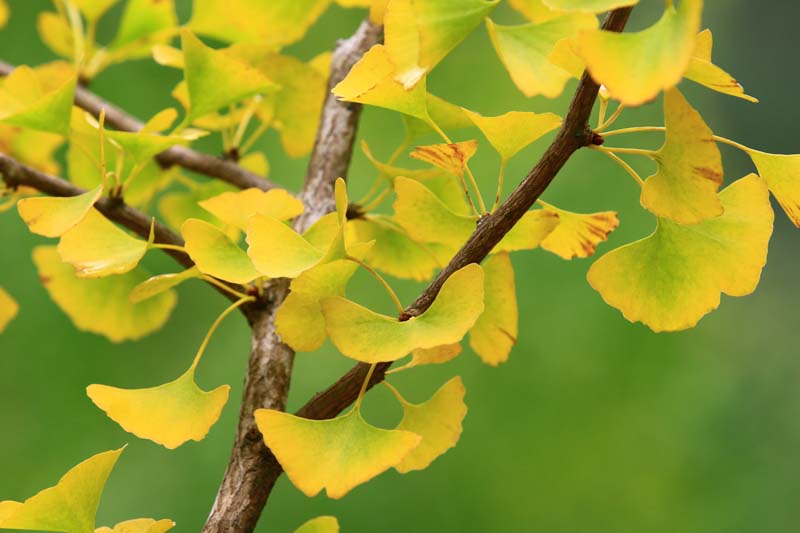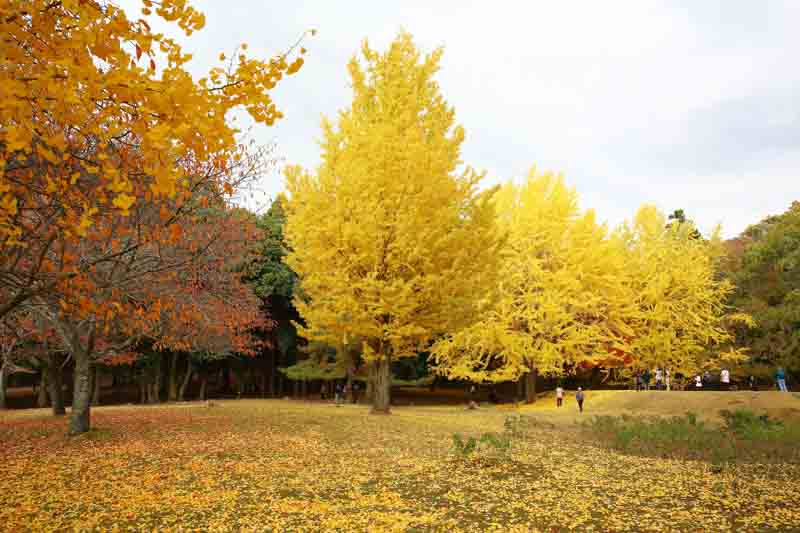The Ginkgo biloba tree enhances any garden with its stunning fall color and offers numerous benefits
Ginkgo biloba, commonly known as the maidenhair tree, is renowned for its distinctive fan-shaped leaves and status as a living fossil, unchanged for over 200 million years. This deciduous tree is celebrated for its resilience and striking yellow fall foliage, making it a popular choice in urban and garden settings.
Native: Originally from China, Ginkgo biloba is the sole survivor of the ancient order of Ginkgoales. It has been cultivated for centuries in East Asia and is now planted worldwide. It is the only existing species within the Ginkgophyta division, making its family, Ginkgoaceae, unique in the plant kingdom.
One of the most fascinating aspects of Ginkgo biloba is its status as a “living fossil.” It’s the only surviving member of a group of ancient plants that were widespread 270 million years ago. This tree has witnessed significant historical events and changes on Earth, symbolizing resilience and longevity.
Growth Habit: This tree is a deciduous conifer, a rarity as most conifers are evergreen. It’s known for its longevity, with some specimens living over a thousand years.
Size: Ginkgo trees have a tall, pyramidal growth habit when young, becoming more irregular and broader with age. They can reach substantial sizes, typically growing to 50-80 feet in height, with some specimens exceeding 100 feet. They usually have a spread of 30-40 feet at maturity, displaying a distinctive, broad, and sometimes irregular canopy as they age. However, there are smaller cultivars that fit beautifully into smaller gardens where a full-sized ginkgo would be too large.
Flowers: Ginkgo biloba is dioecious, meaning individual trees are either male or female. The male trees produce small, yellowish catkins, while female trees produce ovulate cones. Flowers are not showy and bloom in spring.
Fruits: Female trees produce plum-like seeds with a fleshy outer layer that, when decaying, emits an unpleasant smell. The seeds, however, are edible and valued in East Asian cuisine.
Foliage: The unique, fan-shaped, bright green leaves turn a brilliant yellow in the fall, creating a spectacular display.

The Ginkgo tree’s leaves transform into a brilliant golden hue in autumn
Hardiness: Ginkgo biloba is extremely hardy, tolerating a wide range of temperatures and conditions. It’s suitable for USDA zones 3-9.
Uses: The tree is used ornamentally in landscapes and urban areas for its beauty and pollution tolerance. Ginkgo leaves are also harvested for medicinal purposes, believed to enhance cognitive function.
Wildlife: Ginkgo biloba does not significantly attract wildlife due to its lack of nectar-rich flowers or fleshy fruits. However, its seeds, once they drop and the outer layer is removed, can be consumed by squirrels and certain birds that appreciate the nut inside.
Toxicity: While the seeds are edible when cooked, the outer fleshy layer of the fruit can cause skin irritations and allergic reactions in some people. The seeds contain ginkgotoxin, which can be toxic to humans and pets in large quantities.

Deer and Rabbit: Ginkgo biloba is highly resistant to damage from deer, making it an excellent choice for areas where these animals are prevalent.
Drought / Salt: The Ginkgo tree is remarkably drought-tolerant once established, requiring minimal watering. It is also salt, heat and pollution tolerant.
Invasiveness: Ginkgo biloba is not considered invasive. It grows slowly and does not spread aggressively, making it a safe choice for various landscapes. The roots are not considered invasive either. It has a deep-rooting system that typically does not disrupt sidewalks, foundations, or sewer lines.
| Hardiness |
3 - 9 |
|---|---|
| Heat Zones |
3 - 9 |
| Climate Zones | 1, 1A, 1B, 2, 2A, 2B, 3, 3A, 3B, 4, 5, 6, 7, 8, 9, 10, 12, 14, 15, 16, 17, 18, 19, 20, 21, 22, 23, 24, A3 |
| Plant Type | Conifers, Shrubs, Trees |
| Plant Family | Ginkgoaceae |
| Genus | Ginkgo |
| Exposure | Full Sun |
| Season of Interest |
Spring (Mid, Late) Summer (Early, Mid, Late) Fall |
| Height |
50' - 80' (15.2m - 24.4m) |
| Spread |
30' - 40' (9.1m - 12.2m) |
| Maintenance | Low |
| Water Needs | Average, Low |
| Soil Type | Clay, Loam, Sand, Chalk |
| Soil pH | Acid, Neutral, Alkaline |
| Soil Drainage | Well-Drained |
| Characteristics | Showy |
| Tolerance | Deer, Drought, Clay Soil, Salt |
| Attracts | Birds |
| Landscaping Ideas | Patio And Containers, Beds And Borders |
| Garden Styles | City and Courtyard, Informal and Cottage |
| Hardiness |
3 - 9 |
|---|---|
| Heat Zones |
3 - 9 |
| Climate Zones | 1, 1A, 1B, 2, 2A, 2B, 3, 3A, 3B, 4, 5, 6, 7, 8, 9, 10, 12, 14, 15, 16, 17, 18, 19, 20, 21, 22, 23, 24, A3 |
| Plant Type | Conifers, Shrubs, Trees |
| Plant Family | Ginkgoaceae |
| Genus | Ginkgo |
| Exposure | Full Sun |
| Season of Interest |
Spring (Mid, Late) Summer (Early, Mid, Late) Fall |
| Height |
50' - 80' (15.2m - 24.4m) |
| Spread |
30' - 40' (9.1m - 12.2m) |
| Maintenance | Low |
| Water Needs | Average, Low |
| Soil Type | Clay, Loam, Sand, Chalk |
| Soil pH | Acid, Neutral, Alkaline |
| Soil Drainage | Well-Drained |
| Characteristics | Showy |
| Tolerance | Deer, Drought, Clay Soil, Salt |
| Attracts | Birds |
| Landscaping Ideas | Patio And Containers, Beds And Borders |
| Garden Styles | City and Courtyard, Informal and Cottage |
Create a membership account to save your garden designs and to view them on any device.
Becoming a contributing member of Gardenia is easy and can be done in just a few minutes. If you provide us with your name, email address and the payment of a modest $25 annual membership fee, you will become a full member, enabling you to design and save up to 25 of your garden design ideas.
Join now and start creating your dream garden!
Create a membership account to save your garden designs and to view them on any device.
Becoming a contributing member of Gardenia is easy and can be done in just a few minutes. If you provide us with your name, email address and the payment of a modest $25 annual membership fee, you will become a full member, enabling you to design and save up to 25 of your garden design ideas.
Join now and start creating your dream garden!